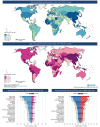Addressing the worldwide hepatocellular carcinoma: epidemiology, prevention and management
- PMID: 34422400
- PMCID: PMC8343080
- DOI: 10.21037/jgo.2020.02.08
Addressing the worldwide hepatocellular carcinoma: epidemiology, prevention and management
Abstract
Hepatocellular carcinoma (HCC) is the sixth most common cancer in the world with rising incidence. Globally, there has been substantial variation in prevalence of risk factors for HCC over years, like control of viral hepatitis in developing countries but growing epidemic of fatty liver disease in developed world. Changing epidemiology of HCC is related to trends in these risk factors. HCC remains asymptomatic until it is very advanced which makes early detection by surveillance important in reducing HCC related mortality. Management of HCC. depends on stage of the tumor and severity of underlying liver disease. At present, resection and transplant are still the best curative options for small HCC, but recent advances in locoregional therapy and molecular targeted systemic therapy has changed the management for HCC at intermediate and advanced stages. This review is overview of global epidemiology, prevention, surveillance and emerging therapies for hepatocellular carcinoma.
Keywords: Hepatocellular carcinoma (HCC); liver transplant; resection; trans arterial chemoembolization (TACE).
2021 Journal of Gastrointestinal Oncology. All rights reserved.
Conflict of interest statement
Conflicts of Interest: The authors have completed the ICMJE uniform disclosure form (available at http://dx.doi.org/10.21037/jgo.2020.02.08). The series “Global GI Malignancies” was commissioned by the editorial office without any funding or sponsorship. The authors have no other conflicts of interest to declare.
Figures
References
-
- World Health Organization. Projections of mortality and causes of death, 2016 to 2060. Accessed October 27, 2019. Available online: http://www.who.int/healthinfo/global_burden_disease/projections/en/
-
- Marrero JA. Current Treatment Approaches in HCC. Clin Adv Hematol Oncol 2013;11 Suppl 5:15-8. - PubMed
Publication types
LinkOut - more resources
Full Text Sources
Medical
Miscellaneous


